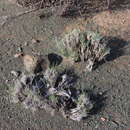Description
provided by eFloras
Caespitose perennial forming dense clumps; culms up to 35 cm high, one-noded, the node black. Leaf-blades filiform, tightly inrolled, 3-12 cm long, smooth and glabrous or sometimes long villous, stiff, curved or flexuous. Panicle 4-17cm long, contracted. Spikelets pallid or tinged with purple; glumes glabrous, subequal, 8-10.5 mm long; lemma 2-2.7 mm long, smooth, abruptly contracted above into the awn; callus 1 mm long, acute, bearded, the hairs on the callus short, those at the base of the lemma longer; column of awn 5-9(14) mm long, glabrous; central branch of the awn 2.5.4 cm long, conspicuously purple, plumose to the tip in the upper half or two-thirds; lateral branches glabrous, 10-18 mm long.
- license
- cc-by-nc-sa-3.0
- copyright
- Missouri Botanical Garden, 4344 Shaw Boulevard, St. Louis, MO, 63110 USA
Distribution
provided by eFloras
Distribution: Pakistan (Baluchistan); North Africa from Morocco to Egypt; Arabia eastwards to Pakistan; South Africa.
- license
- cc-by-nc-sa-3.0
- copyright
- Missouri Botanical Garden, 4344 Shaw Boulevard, St. Louis, MO, 63110 USA
Flower/Fruit
provided by eFloras
Fl. & Fr. Per.: March-April and again in October-November.
- license
- cc-by-nc-sa-3.0
- copyright
- Missouri Botanical Garden, 4344 Shaw Boulevard, St. Louis, MO, 63110 USA
Stipagrostis obtusa: Brief Summary
provided by wikipedia EN
Stipagrostis obtusa (Afrikaans: kortbeen boesmangras, Khoekhoe: ǂhabob, Hebrew: מלענן ריסני) is a perennial grass belonging to the grass family (Poaceae). It is a widespread species, being native to North Africa, Mauritania, Chad, Ethiopia, Southern Africa, Western Asia, the Arabian Peninsula and Pakistan.
Stipagrostis obtusa is used as fodder grass in Namibia, it can survive on an annual rainfall of about 150 millimetres (5.9 in).

Wikimedia Commons has media related to
Stipagrostis obtusa.
- license
- cc-by-sa-3.0
- copyright
- Wikipedia authors and editors

